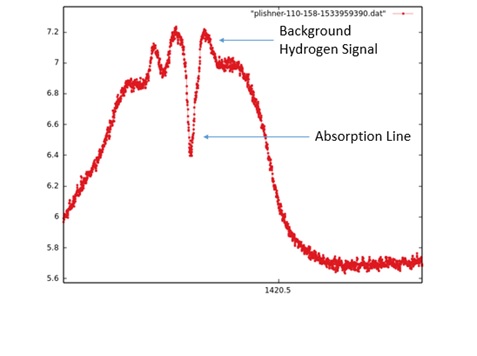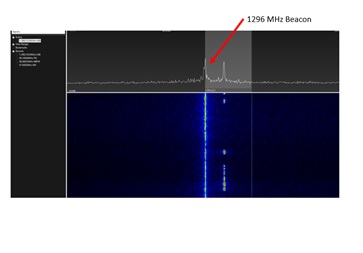Editor’s note: During the DSES Open House on the weekend of August 11, 2018, three receiver systems were tested on the 60-foot dish antenna. Dr. Richard Russel reports on their successful results, and he shows what we see in our data plots. Some highlights to point out:
- The Spectracyber definitively observed the neutral hydrogen of the Milky Way as the beam width completely crossed the galactic plane.
- The RASDR4 observed a known neutral hydrogen radio source, which has a closer cloud along the line of sight that absorbs some of the hydrogen signal. The distinctive signal feature is known from published data by the Parkes Radio Observatory in Australia.
- The RASDR2 detected a 1296 MHz beacon set up at the home of a member about 80 miles away. This is our first definitive detection of a beacon at 1296 MHz.
-Gary Agranat, website editor.
Open House Observations using the 60-foot Dish Antenna
The DSES and Society of Amateur Radio Astronomers (SARA) teams installed three different receivers onto the 60-foot dish during the open house.
Successful Installation and Testing of the DSES Spectracyber Neutral Hydrogen Receiver.
The Spectracyber was installed on the 60-foot dish during the DSES Open House on August 11, 2018.
The Spectracyber measures 1420.406 MHz +- 600 KHz. The observation was taken while passing the galactic plane at RA: 19hr 5 Min, Dec: 6 degrees 0 Min.
The observation shows a significant signal to noise ratio as seen below.

Follow-on observations will allow for measurement of the rotation rate of the Milky Way and Solar System!
RASDR4 Receiver Successful Observation of Hydrogen Absorption Line
Tony Bigbee used his RASDR4 on the 60-foot dish to observe this hydrogen absorption line at RA: 18.15hrs, Dec:-20 deg.
This target is a hydrogen source with a cloud of material between the source and Earth that absorbs the hydrogen energy resulting in a drop off of signal as shown below.

1296 MHz Beacon Observation using a RASDR2
Bogdan Vacaliuc installed a RASDR2 onto the 60-foot dish and was able to observe the 1296 MHZ beacon at Ray Uberecken’s house, about 80 statute miles distance to the west-northwest. This observation helped verify the azimuth pointing accuracy of the 60-foot dish.
